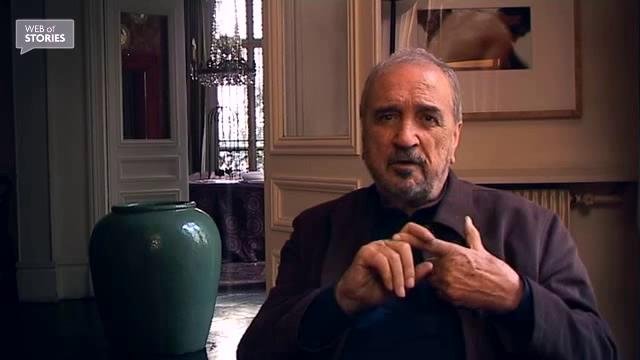NEXT STORY

Learning to say no to Buñuel
RELATED STORIES

NEXT STORY

Learning to say no to Buñuel
RELATED STORIES


|
Views | Duration | |
|---|---|---|---|
| 21. Tati the great observer | 1 | 184 | 01:34 |
| 22. Friendship with Pierre Etaix | 110 | 02:38 | |
| 23. Our reclaimed films | 95 | 00:44 | |
| 24. Meeting Buñuel | 1 | 198 | 03:13 |
| 25. Work begins on 'The Diary of a Chambermaid' | 132 | 01:55 | |
| 26. Learning to say no to Buñuel | 171 | 03:51 | |
| 27. Sharing a Mediterranean culture with Buñuel | 172 | 01:39 | |
| 28. A common religious background | 124 | 00:25 | |
| 29. 'Le Ruban blanc': an anthropological study | 123 | 01:46 | |
| 30. Fanaticism | 1 | 127 | 01:00 |


So the surrealists felt some kinship, some connection with slapstick and American burlesque. So both of those things linked us together, and then of course, I had read Mirbeau's book and worked on it, and had some idea on how to adapt it. The novel describes several jobs where the chambermaid goes from one family to another. So as to avoid the sketch film, I had thought of fusing together several of those masters or of marrying them, or turning them into one family. I said to Buñuel, that we could merge that character with the other and he had had the same idea. So that brought us together. We spent two hours together; I came back to Paris without having gone to the festival. I took the plane back that afternoon, and eight days later I found out that I had to leave for Spain, and that was to work with Luis. He really took a risk, as he had only seen me for two hours, he couldn't have had any idea if I had any talent at all, and from my point of view it was very impressive to work with someone who was already so established in the film business. He had filmed Veridiana, he had done the Exterminating Angel, he had won the Grand Prize in Cannes, so it was at that time he was 63 and I was 30... 31, so it was fascinating, and at the beginning I was very impressed. He put me at ease right away, he cleverly made me understand how we ought to work. I mean I was in Madrid, we both had flats in a building in Madrid called 'la Torre de Madrid', a skyscraper in Madrid, that is still there.
Donc les surréalistes se reconnaissaient une parenté, quelque chose de commun avec le slapstick et burlesque américains. Donc ces deux points là nous rapprochaient et il se trouvait aussi que, bien entendu, j’avais lu le livre de Mirbeau Le Journal d’une femme de chambre, je l’avais travaillé, j’avais eu une idée d’adaptation… Le roman de Mirbeau est une suite de postes ou la femme de chambre va d’un maître à l’autre. Pour éviter l’aspect film à sketch, je m’étais dit qu’on pouvait prendre plusieurs de ces maîtres et ou les marier ou en faire une seule famille. J’ai dit ça à Buñuel, on pouvait mettre un tel personnage avec tel autre et il ma dit: «J’ai eu la même idée». Donc ça c’était déjà un point qui nous rapprochait, c’est tout. Nous avons passé deux heures ensemble, je suis entré à Paris sans mettre le pied au festival de Cannes, du tout. J’ai repris l’avion le jour même, l’après-midi et huit jours après j’apprenais que je partais en Espagne, ça c’étais évidemment la… pour travailler avec Luis. De sa part c’était très risqué parce que il m’a vu deux heures, il ne pouvait pas se douter si j’avais la moindre… bribe de talent ou pas et de ma part c’était une aventure très impressionnante de me retrouver face à face avec quelqu’un qui était déjà un monument de cinéma. Il avait fait Veridiana, il avait fait l’Ange Exterminateur, il avait eu le grand Prix à Cannes donc c’était… il avait à l’époque 63 ans et moi j’en avais 30, 31 donc c’était une aventure impressionnante qui m’a impressionné au début. Il m’a très vite mit à l’aise, il m’a fait comprendre d’une manière très habile comment nous devions travailler. C’est à dire que… j’étais à Madrid, nous avions deux appartements dans un immeuble moderne qui s’appelle la Torre de Madrid, un gratte-ciel de Madrid, qui existe toujours.
French screenwriter Jean-Claude Carrière (1931-2021) began his association with films aged 24 when he was selected by Jacques Tati to write for him. This early experience led to further contact with other film-makers, including Luis Buñuel with whom Carrière collaborated for many years. He wrote screenplays for films including Belle de Jour, The Discreet Charms of the Bourgeoisie, Tin Drum and Danton.
Title: Work begins on 'The Diary of a Chambermaid'
Listeners: Andrzej Wolski
Film director and documentary maker, Andrzej Wolski has made around 40 films since 1982 for French television, the BBC, TVP and other TV networks. He specializes in portraits and in historical films. Films that he has directed or written the screenplay for include Kultura, which he co-directed with Agnieszka Holland, and KOR which presents the history of the Worker’s Defence Committee as told by its members. Andrzej Wolski has received many awards for his work, including the UNESCO Grand Prix at the Festival du Film d’Art.
Tags: The Diary of a Chambermaid, Luis Buñuel, Octave Mirbeau
Duration: 1 minute, 55 seconds
Date story recorded: January 2010
Date story went live: 26 July 2010